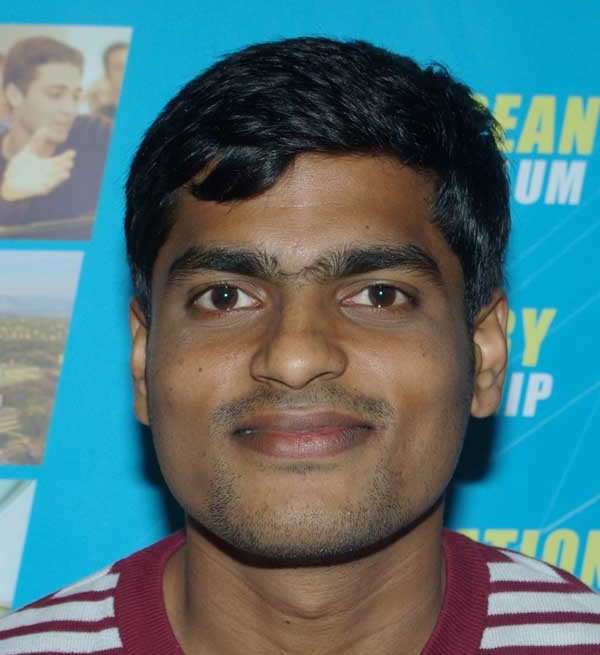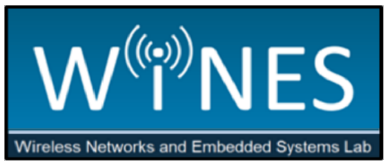Education
- Ph.D. in Electronics and Communications (2015) - Télécom ParisTech (EURECOM), France
- M.Sc in Mobile Communications (2012) - Télécom ParisTech (EURECOM), France
Research Interests
- Open RAN (O-RAN), 5G & Beyond Cellular Networks
- Positioning and Sensing
- Wireless Testbeds, Software-defined Networks
- Cognitive Radio and Spectrum Sharing
- Connected Robotics
Rajeev Gangula is a Research Assistant Professor at the Institute for the Wireless Internet of Things, Northeastern University. He obtained a Ph.D. degree from Télécom ParisTech (EURECOM), France in July 2015. After Ph.D., he held research engineer positions at Sequans Communications, Paris, and Eurecom, Biot, France. While working as a research engineer at Eurecom, he was leading the prototyping activity in autonomous flying radio access networks. His current research focuses on positioning and sensing in beyond-5G networks, dynamic spectrum sharing, and connected autonomous systems.
Publications
2025
Journals and Magazines
Open Radio Access Networks (RANs) leverage disaggregated and programmable RAN functions and open interfaces to enable closed-loop, data-driven radio resource management. This is performed through custom intelligent applications on the RAN Intelligent Controllers (RICs), optimizing RAN policy scheduling, network slicing, user session management, and medium access control, among others. In this context, we have proposed dApps as a key extension of the O-RAN architecture into the real-time and user-plane domains. Deployed directly on RAN nodes, dApps access data otherwise unavailable to RICs due to privacy or timing constraints, enabling the execution of control actions within shorter time intervals. In this paper, we propose for the first time a reference architecture for dApps, defining their life cycle from deployment by the Service Management and Orchestration (SMO) to real-time control loop interactions with the RAN nodes where they are hosted. We introduce a new dApp interface, E3, along with an Application Protocol (AP) that supports structured message exchanges and extensible communication for various service models. By bridging E3 with the existing O-RAN E2 interface, we enable dApps, xApps, and rApps to coexist and coordinate. These applications can then collaborate on complex use cases and employ hierarchical control to resolve shared resource conflicts. Finally, we present and open-source a dApp framework based on OpenAirInterface (OAI). We benchmark its performance in two real-time control use cases, i.e., spectrum sharing and positioning in a 5th generation (5G) Next Generation Node Base (gNB) scenario. Our experimental results show that standardized real-time control loops via dApps are feasible, achieving average control latency below 450 microseconds and allowing optimal use of shared spectral resources.
LinkPatents
2024
Journals and Magazines
The fifth-generation new radio (5G NR) technology is expected to provide precise and reliable positioning capabilities along with high data rates. The Third Generation Partnership Project (3GPP) has started introducing positioning techniques from Release-16 based on time, angle, and signal strength using reference signals. However, validating these techniques with experimental prototypes is crucial before successful real-world deployment. This work provides useful tools and implementation details that are required in performing 5G positioning experiments with OpenAirInterface (OAI). As an example use case, we present an round trip time (RTT) estimation test-bed based on OAI and discusses the real-word experiment and measurement process.
LinkIn the context of fifth-generation new radio (5G NR) technology, it is not possible to directly obtain an absolute uplink (UL) channel impulse response (CIR) at the base station (gNB) from a user equipment (UE). The UL CIR obtained through the sounding reference signal (SRS) is always time-shifted by the timing advance (TA) applied at the UE. The TA is crucial for maintaining UL synchronization, and transmitting SRS without applying the TA will result in interference. In this work, we propose a new method to obtain absolute UL CIR from a UE and then use it to estimate the round trip time (RTT) at the gNB. This method requires enhancing the current 5G protocol stack with a new Zadoff-Chu (ZC) based wideband uplink reference signal (URS). Capitalizing on the cyclic shift property of the URS sequence, we can obtain the RTT with a significant reduction in overhead and latency compared to existing schemes. The proposed method is experimentally validated using a real-world testbed based on OpenAirInterface (OAI).
LinkThe fifth generation new radio (5G NR) technology is expected to fulfill reliable and accurate positioning requirements of industry use cases, such as autonomous robots, connected vehicles, and future factories. Starting from Third Generation Partnership Project (3GPP) Release-16, several enhanced positioning solutions are featured in the 5G standards, including the multi-cell round trip time (multi-RTT) method. This work presents a novel framework to estimate the round-trip time (RTT) between a user equipment (UE) and a base station (gNB) in 5G NR. Unlike the existing scheme in the standards, RTT can be estimated without the need to send timing measurements from both the gNB and UE to a central node. The proposed method relies on obtaining multiple coherent uplink wide-band channel measurements at the gNB by circumventing the timing advance control loops and the clock drift. The performance is evaluated through experiments leveraging a real world 5G testbed based on OpenAirInterface (OAI). Under a moderate system bandwidth of 40MHz, the experimental results show meter level range accuracy even in low signal-to-noise ratio (SNR) conditions.
LinkRecent years have witnessed the Open Radio Access Network (RAN) paradigm transforming the fundamental ways cellular systems are deployed, managed, and optimized. This shift is led by concepts such as openness, softwarization, programmability, interoperability, and intelligence of the network, which have emerged in wired networks through Software-defined Networking (SDN) but lag behind in cellular systems. The realization of the Open RAN vision into practical architectures, intelligent data-driven control loops, and efficient software implementations, however, is a multifaceted challenge, which requires (i) datasets to train Artificial Intelligence (AI) and Machine Learning (ML) models; (ii) facilities to test models without disrupting production networks; (iii) continuous and automated validation of the RAN software; and (iv) significant testing and integration efforts. This paper is a tutorial on how Colosseum—the world’s largest wireless network emulator with hardware in the loop—can provide the research infrastructure and tools to fill the gap between the Open RAN vision, and the deployment and commercialization of open and programmable networks. We describe how Colosseum implements an Open RAN digital twin through a high-fidelity Radio Frequency (RF) channel emulator and endto- end softwarized O-RAN and 5G-compliant protocol stacks, thus allowing users to reproduce and experiment upon topologies representative of real-world cellular deployments. Then, we detail the twinning infrastructure of Colosseum, as well as the automation pipelines for RF and protocol stack twinning. Finally, we showcase a broad range of Open RAN use cases implemented on Colosseum, including the real-time connection between the digital twin and real-world networks, and the development, prototyping, and testing of AI/ML solutions for Open RAN.
LinkConference Papers
Network slicing allows Telecom Operators (TOs) to support service provisioning with diverse Service Level Agreements (SLAs). The combination of network slicing and Open Radio Access Network (RAN) enables TOs to provide more customized network services and higher commercial benefits. However, in the current Open RAN community, an open-source end-to-end slicing solution for 5G is still missing. To bridge this gap, we developed ORANSlice, an open-source network slicing-enabled Open RAN system integrated with popular open-source RAN frameworks. ORANSlice features programmable, 3GPP-compliant RAN slicing and scheduling functionalities. It supports RAN slicing control and optimization via xApps on the near-real-time RAN Intelligent Controller (RIC) thanks to an extension of the E2 interface between RIC and RAN, and service models for slicing. We deploy and test ORANSlice on different O-RAN testbeds and demonstrate its capabilities on different use cases, including slice prioritization and minimum radio resource guarantee.
LinkThis demo paper presents a dApp-based real-time spectrum sharing scenario where a 5th generation (5G) base station implementing the NR stack adapts its transmission and reception strategies based on the incumbent priority users in the Citizen Broadband Radio Service (CBRS) band. The dApp is responsible for obtaining relevant measurements from the Next Generation Node Base (gNB), running the spectrum sensing inference, and configuring the gNB with a control action upon detecting the primary incumbent user transmissions. This approach is built on dApps, which extend the O-RAN framework to the real-time and user plane domains. Thus, it avoids the need of dedicated Spectrum Access Systems (SASs) in the CBRS band. The demonstration setup is based on the open-source 5G OpenAirInterface (OAI) framework, where we have implemented a dApp interfaced with a gNB and communicating with a Commercial Off-the-Shelf (COTS) User Equipment (UE) in an over-the-air wireless environment. When an incumbent user has active transmission, the dApp will detect and inform the primary user presence to the gNB. The dApps will also enforce a control policy that adapts the scheduling and transmission policy of the Radio Access Network (RAN). This demo provides valuable insights into the potential of using dApp-based spectrum sensing with O-RAN architecture in next generation cellular networks.
Link
